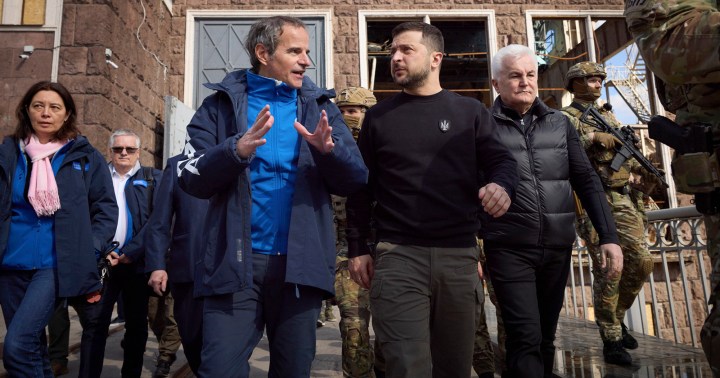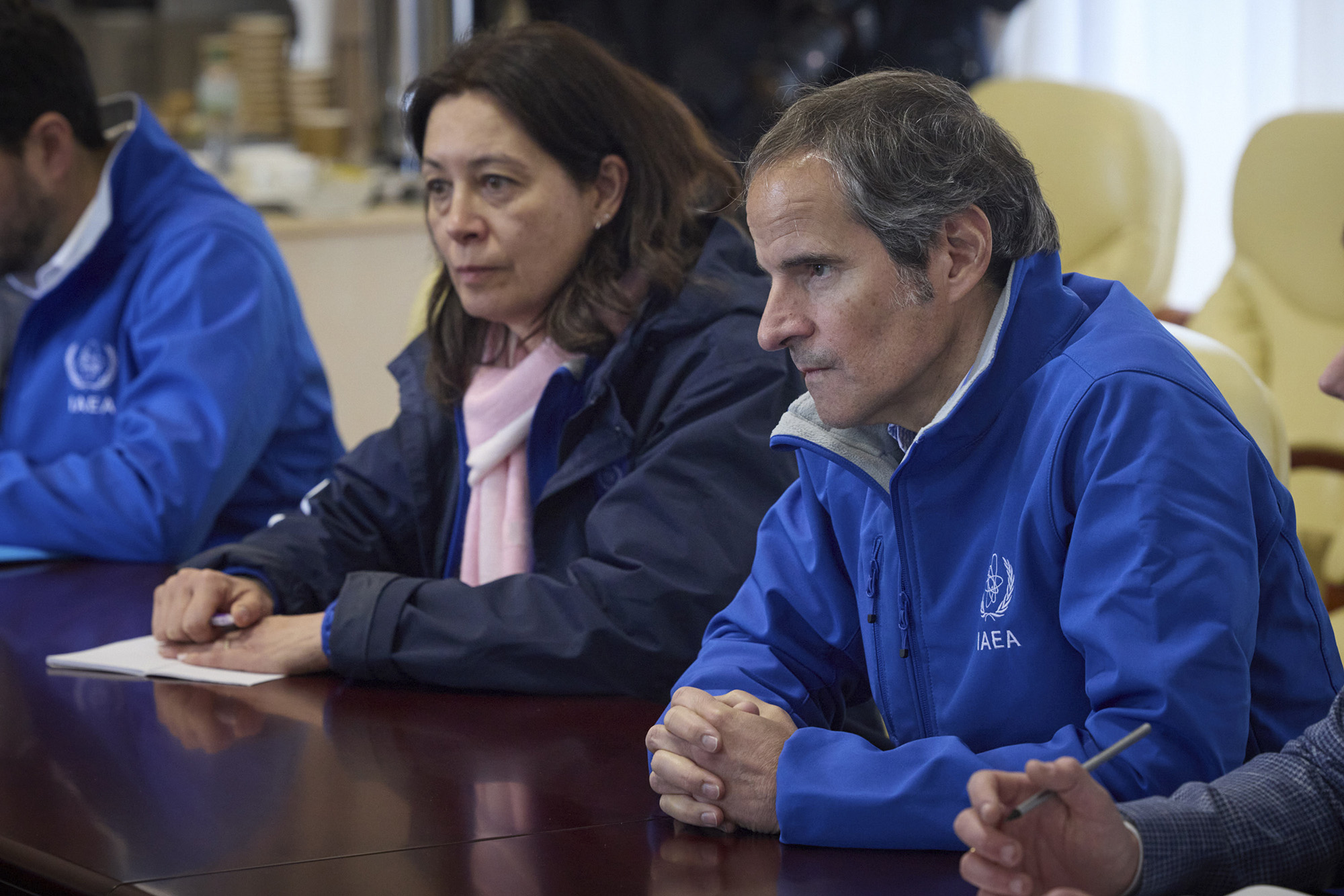WAR IN EUROPE
High risk of nuclear meltdown at Ukraine’s Zaporizhzhia power plant, says former operations director

Ex-director Oleg Dugar has warned South Africa against doing any nuclear deal with Russia.
Ukraine’s Zaphorizhzhia nuclear power plant is at dire risk of a meltdown because of Russia’s occupation, says the station’s last operations director, Oleg Dugar. And if the last remaining cooling system breaks down, the radioactive pollution will flow all the way to the Mediterranean.
“It will be a disaster on a European scale,” he told a webinar in Cape Town about the nuclear safety and environmental consequences of the Russian invasion of Ukraine.

International Atomic Energy Agency Director-General Rafael Mariano Grossi (right) attends a meeting with Ukrainian President Volodymyr Zelensky (not pictured) at the Dnieper Hydroelectric Station in Zaporizhzhia, Ukraine, on 27 March 2023. (Photo: EPA-EFE / Ukrainian Presidential Press Service Handout)
He was speaking a day after Rafael Grossi, director-general of the International Atomic Energy Agency, met Ukrainian President Volodymyr Zelensky in the nearby Ukrainian-held city of Zaporizhzhia.
Grossi also expressed dire concerns about the dangers of an atomic catastrophe at the nuclear power plant. Reports that Ukraine is about to launch a major counteroffensive to retake southern territory including the nuclear power plant have heightened fears of major damage.
Dugar said he was at the 5,700-megawatt nuclear power plant when the invading Russians shelled and occupied it on the night of 4 March last year. He says he witnessed the Russians assaulting and torturing his staff – and also protesters in the nearby city of Enerhodar. He was expelled last September and left the country.
South Africa warned
Dugar – referring to the secret negotiations between former president Jacob Zuma and Russian President Vladimir Putin to build a Russian nuclear power station in South Africa – strongly warned South Africa not to enter any nuclear deals with Russia. He cited both its irresponsible handling of nuclear energy in its seizure and occupation of the Zaphorizhzhia nuclear power plant and what he said was its readiness to use nuclear energy as a lever to blackmail other countries into accepting unfavourable political terms.
Dugar noted that all of Ukraine’s 15 nuclear power reactors had been built on Russian designs and said that in the early 2000s, Moscow had withheld nuclear fuel from Ukraine to force it to accept political concessions.
He said he had witnessed live through cameras the Russians shelling and occupying the Zaphorizhzhia plant on 4-5 March – the first time a nuclear power station had been attacked in war.
Russia has shut down all the plant’s six reactors – probably as part of its strategy of starving Ukraine of electrical power. The strategy includes the constant bombing of Ukraine’s conventional energy infrastructure. Dugar noted that a nuclear power plant could not simply be switched off and locked up.
It required a constant supply of electricity to maintain the systems cooling its nuclear fuel.
“Right now these are in terrible condition,” he said. Only one line now connected the nuclear plant to the power grid. There were also generators which should kick in if this line was broken. But there were only 10 days of diesel to run the generators.
Massive radioactivity
If the power line was cut and the diesel ran out – or the generators were damaged by shelling – the temperature inside the reactors would rise rapidly, the coolant water would evaporate and the nuclear fuel would burn through its concrete casing. The Dnieper River would then carry massive radioactivity down into the Black Sea and from there to the Mediterranean, Dugar said.
A nuclear plume would contaminate vast areas of farmland, aggravating the global food shortage caused by the war, as Ukraine is one the world’s largest grain producers.
The contaminated exclusion zone around the Zaporizhzhia NPP, if a nuclear accident occurred, would be an estimated 30,000km², almost 10 times larger than the Chernobyl exclusion zone, Artem Kolesnyk of Ecoaction Ukraine told the webinar.
Already, as of 18 February, 14 million square metres of Ukraine are littered with the debris of destroyed objects and ammunition and more than 280,000m² of soil have been contaminated with dangerous substances, he said.
Koeberg dangers
Lydia Petersen, spokesperson for the Koeberg Alert Alliance, speaking on nuclear lessons from Ukraine, suggested many of the dangers of a meltdown at Zaphorizhzhia were replicated at South Africa’s only nuclear power plant, Koeberg, near Cape Town, though some were in a different form.
Anything could go wrong, she said. At Zaphorizhzhia, the main threat was an invasion; at Koeberg it could be an earthquake damaging roads and the power grid. She noted that South Africa’s volatile politics could cause civil unrest which could block the access of vital safety staff to Koeberg or the delivery of diesel to the backup generators for the plant’s cooling system if the plant lost its electricity grid supply. This would be particularly dangerous if Eskom experienced a total grid collapse, which would take an estimated 14 days to restart. She noted the US embassy had recently warned of the risk of this eventuality.
Petersen also noted that there were several possible geopolitical consequences of South Africa doing business with Russia. She cited the recent decision by the US nuclear authorities not to renew Westinghouse’s supply of nuclear fuel to Koeberg.
Petersen suggested that South Africa’s participation in the US’s Africa Growth and Opportunity Act, which gives South African exports privileged access to the US market; SA’s free trade deal with the European Union, and the Just Energy Transition Partnership, through which several Western nations are providing SA with $8.5-billion to transition to renewable energy, could all be jeopardised by Pretoria’s friendship with Moscow.
Petersen also expressed suspicion that South Africa might be contemplating providing Russia with spent nuclear fuel from Koeberg to make nuclear weapons. She said she had recently asked Eskom official Keith Featherstone where Eskom planned to store all of Koeberg’s spent fuel if the life of the plant was extended by 20 years, as contemplated.
She said he had replied that Eskom would store it on-site until it had decided on an alternative.
Spent nuclear fuel
Looking at South Africa’s warming relations with Russia, she wondered if Pretoria might not be considering providing Moscow with spent Koeberg fuel – a source of plutonium for nuclear weapons – in (part) exchange for a nuclear power station.
Jo-Ansie van Wyk, a professor of international relations at Unisa, said the Zaporizhzhia experience underscored the need for international criminal law to be revised to include crimes against nuclear safety.
Dzvinka Kachur of the Ukrainian Association of South Africa said one of the reasons South Africa should be more sympathetic to Ukraine in its war with Russia was that Ukraine, like South Africa, had voluntarily abandoned its nuclear weapons in the 1990s. In addition, Russia – along with the US and the UK – had given Ukraine security assurances in exchange for giving up its nuclear arsenal.
The webinar was organised by the Ukrainian Association of South Africa, the Koeberg Alert Alliance and the Southern African Faith Communities Environment Institute. DM


















 Become an Insider
Become an Insider
Comments - Please login in order to comment.